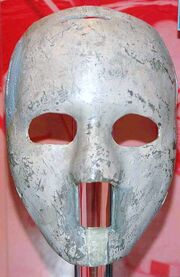
Jacques Plante's original fiberglass mask
A goaltender mask, commonly referred to as a goalie mask or a hockey mask, is a mask worn by ice hockey, inline hockey, and field hockey goaltenders to protect the head from injury. Jacques Plante was the first goaltender to create and use a practical mask in 1959. Plante's mask was a piece of fiberglass that was contoured to his face. This mask later evolved into a helmet/cage combination, and single piece full fiberglass mask. Today, the full fiberglass mask is the more popular option because it is safer.
History[]
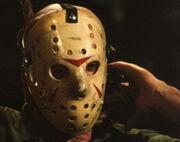
Jason Voorhees wearing the now-iconic goalie mask. It was made by being molded from a Detroit Red Wings goalie mask. It would become a staple for the character for the rest of the series, and had an instant impact on pop culture.
The first goaltender mask was a fiberglass fencing mask donned in February 1927 by Queen's University netminder Elizabeth Graham, mainly to protect her teeth. In 1930, the first crude leather model of a mask (actually an American football "nose-guard") was worn by Clint Benedict to protect his broken nose.[1] After recovering from the injury, he abandoned the mask, never wearing one again in his career. At the 1936 Winter Olympics, Teiji Honma wore a crude mask, similar to the one worn by baseball catchers. The mask was made of leather, and had a wire cage which protected the face, as well as Honma's large circular glasses.
It was not until 1959 that a goaltender wore a mask full-time. On November 1, 1959, in a game between the Montreal Canadiens and New York Rangers of the National Hockey League (NHL), Canadiens goaltender Jacques Plante was struck in the face by a shot from Andy Bathgate. Plante had previously worn his mask in practice, but coach Toe Blake refused to permit him to wear it in a game, fearing it would inhibit his vision. After being stitched up, Plante gave Blake an ultimatum, refusing to go back out onto the ice without the mask, to which Blake obliged not wanting to forfeit the game since NHL teams did not carry back-up goaltenders. Plante went on a long unbeaten streak wearing the mask, which stopped when he was asked to remove it for a game. He donned the mask for the rest of his career after. When Plante introduced the mask into the game, many questioned his dedication and bravery; in response, Plante made an analogy to a person skydiving without a parachute.
Although Plante faced some laughter, the fiberglass goaltender mask soon became the standard and a symbol of the game as typified by the famous painting "At The Crease," by Ken Danby. This style of mask is no longer used by hockey leagues, yet its fame continues because of its use by horror movie icon Jason Voorhees of the Friday the 13th film series.[2] Casey Jones of the Teenage Mutant Ninja Turtles franchise also wears a stylized version of the mask, as did D-Roc the Executioner, the late guitarist of the heavy metal band Body Count.[3] Since the invention of the fiberglass hockey mask, professional goaltenders no longer play without a mask. The last goaltender to play without a mask was Andy Brown, who played his last NHL game in 1974.[4]
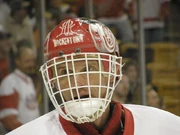
The cage/helmet combo mask, worn by Dominik Hašek.
The goaltender mask evolved further from the original face-hugging fiberglass mask designed by Plante. In the 1970s, a helmet/cage combination became popular, which was popularized by Vladislav Tretiak, the noted Russian goaltender who competed against Canada in the 1972 Summit Series. Like the original fiberglass design, the helmet/cage combination has been criticized for not providing adequate facial/cranial protection. Dan Cloutier switched from this type of mask to the widely more popular full fiberglass citing safety reasons upon the advice of the Los Angeles Kings. Dominik Hašek, a Hart Trophy and Vezina Trophy-winner in the late 1990s used this type of mask; Hašek retired from the NHL in 2008. Rick DiPietro of the New York Islanders, is one of the last NHL goalies to use this type of mask. [5] Goalies at lower levels of hockey (such as high-school, college, or recreational leagues) who choose to use this design cite reasons such as the plastic helmet used is lighter than the fiberglass or composite materials used in other designs, and that the helmet has a wider opening than a traditional mask for a less claustrophobic feeling and better sight of the puck.
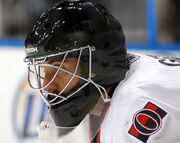
A standard (typical) full fiberglass/Kevlar mask, as worn by Martin Gerber.
The second type of goaltender mask is a fiberglass mask with a cage attached in the middle. It can also be made out of carbon fiber, or a fiberglass and kevlar mix. These masks are able to better withstand the impacts of hockey puck at higher speeds and are used at all levels of organized ice hockey. These masks are considered safer since they disperse the impact of the puck better than the helmet/cage combination. Tim Thomas of the Boston Bruins wears a newer style one piece called a Sportmask Mage RS, made like the newer fiberglass mask, but resembles the helmet/cage combination.[6]
Tactical play[]
The advent of the goaltender mask changed the way goaltenders play, allowing them to make more saves on their knees without fear of serious head or facial injuries. Before the advent of the mask, most goaltenders stayed standing as much as possible. In the modern era, a goaltender is likely to make the majority of saves when he has one or both knees on the ice. With the technological advancement of the mask, shots hitting the head cause more temporary discomfort instead of serious concussions and lacerations; however, a mask does not guarantee avoiding injury, and goaltenders have been concussed by a shot hitting the head. Some goaltenders, like Dominik Hasek and Henrik Lundqvist, have used their heads intentionally to stop shots. Lundqvist said that his reason for this is to not obstruct his vision by placing his catching glove in front of his mask to stop the shot.
Mask decoration[]

Modern decorated goaltender mask
With the available surface area provided by fiberglass masks, goaltenders find it fashionable to give their mask distinctive decorations. This tradition started with the earliest masks, notably by the now-retired Boston Bruins goalkeeper Gerry Cheevers, who was known for drawing stitches on his mask whenever it got hit.[7] These stitches represented where Cheevers would have been cut had he not been wearing his mask.[8] Modern-day masks also offer this ability, and goaltenders are well-identified with their helmet design, often transferring the motif into their new team's colors when traded or signed to a new team (for example, Patrick Lalime's Marvin the Martian theme, Felix Potvin's cat theme, Curtis Joseph's Cujo theme, or Ed Belfour's eagle theme).
Historical Samples[]
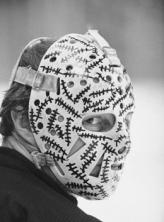
close up of Cheevers in mask
Below is the mask that Clint Benedict used in 1930. The photo to the right is a close up of Gerry Cheevers iconic "stitches" mask.
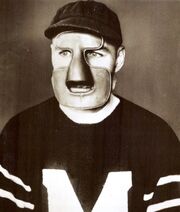
Clint Benedict with mask circa 1930
See also[]
| Wikimedia Commons has media related to: Ice hockey goaltender helmets |
- Hockey helmet
- Teiji Honma (Goaltender for Japan's national team at the 1936 Winter Olympics, who became the first goalie to wear a mask at the Olympics.) The page has a photo of him in his mask.
References[]
- ↑ History of Masks. Archived from the original on 1999-01-16. Retrieved on 2007-06-17.
- ↑ Jason Voorhees figurehead. Retrieved on 2007-06-17.
- ↑ Devenish, Colin (August 19, 2004). Body Count Guitarist Dead. Rolling Stone. Retrieved on 2007-08-24.
- ↑ Andrew Conrad (Andy) Brown. Retrieved on 2007-06-17.
- ↑ http://islanders.nhl.com/club/blogpost.htm?id=2761
- ↑ http://www.sportmask.com/goalie-masks/combo-mage.html
- ↑ Gerry Cheevers. Retrieved on 2007-06-17.
- ↑ Gerry Cheevers Biography. Retrieved on 2007-06-17.
External links[]
- A Brief History of the Goalie Mask
- Head Case: Weird, Wild Hockey Masks - slideshow by Life magazine
